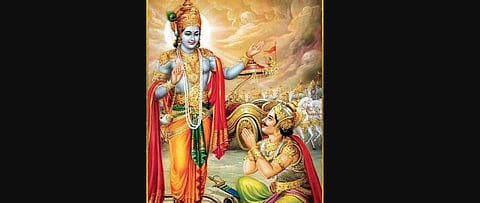

Let us begin with The Bhagavad Gita translation first. It is a verse-by-verse translation, with the Sanskrit shlokas on one page and the English translation on the facing page. There is no interpretation, no commentary; just a literal translation. With over 2,700 translations of the Gita between 1785 and 1979 in 50 identified languages, why do we need another translation? For several reasons. There is an inevitable loss when translating from Sanskrit to English—a loss of context, exact meanings, and of course, the beauty of the Sanskrit poetry which cannot be reproduced in English, no matter how hard one tries. Some words cannot be translated to English with complete fidelity. For example, ‘duty’ is at best a partial translation of the Sanskrit word ‘dharma’. Given these limitations, it becomes all the more important to not compound this loss by translating words without understanding their context.
Debroy tells us that some less than adequate understanding of Sanskrit leads to ‘Gudakesha’ (another of Arjuna’s names which means one who has conquered sleep, derived from ‘gudaka’—sleep, and ‘isha’—lord) being translated as someone ‘whose hair is in a bun’, which is etymologically possible, but contextually implausible. Then there are problems that arise from an incomplete reading of the Mahabharata itself.
Consider also what is lost in translations that substitute words for convenience or otherwise. For instance, in 1.36, Arjuna laments to Krishna, ‘O Janardana! What pleasure will we derive from killing the sons of Dhritarashtra? Although they are criminals, sin alone will be our lot if we kill them.’ To understand why the Kauravas are criminals, you have to read the footnote that tells us that according to the shastras, ‘there are six types of criminals—arsonists, poisoners, those who bear arms to kill you, those who steal wealth, those who steal and those who steal other people’s wives.’ If you substitute the word criminal with evil, you lose something in the translation.
This translation seeks to avoid all such pitfalls. If you want to appreciate Sanskrit, the shlokas are reproduced in Devanagri. In cases where the Sanskrit sentence flows to the next one, rather than combining the translations across all these shlokas, the translation sticks to a verse-by-verse cadence. That makes the job of a reader trying to match the shloka to the English translation easier. Given all this, this book should become a go-to reference for people wanting a faithful, accurate, and copiously footnoted English translation of the Bhagavad Gita. More than 800 footnotes, spread across 60 pages, provide additional notes and context without interrupting the flow of the translation.
The first book is a faithful, verse-by-verse translation. But a more fundamental question may arise in the mind of the reader: how should I read the Gita? Why should I read it? For that, we should turn to the second book—The Bhagavad Gita for Millennials. It seeks to, and succeeds in, introducing the reader to the world of the Gita in its various dimensions. The book also answers several questions as a typical reader may have about the Mahabharata and the Gita. Like, who composed the Mahabharata, why was Krishna Dvaipayana called Vedvyasa, what is the BORI (Bhandarkar Oriental Research Institute) Critical Edition, was the Gita written by one or multiple authors, is the Gita a later interpolation into the Mahabharata, and so on.
Which leads to another natural question—the historicity of the Mahabharata. Or the historicity of the most famous character in the epic—Krishna. Archaeologist BB Lal answered the question on the historicity of the Mahabharata more than half a century ago when he led the excavation and found evidence of several Painted Grey Ware sites dating back to the second millennium BCE. We can rely on the evidence presented by the Chandogya Upanishad that references Krishna, the son of Devaki, the account of the Greek traveler Megasthenes, the Sanskrit grammarian Panini’s 5th or 6th century BCE work, Ashtadhyayi, and so on. The circumstantial evidence points to Krishna as a historical person. It is important to point out that it is the historicity of Krishna that is covered, not his divinity—an important distinction that should not be conflated.
But what makes this book unique is probably the second chapter. The author takes the reader on a whirlwind tour of why there is no substitute to reading the Gita in its original Sanskrit. Because translations cannot be completely recreated, they are often trans-creations, and no translation can capture the beauty of the Sanskrit poetry in the Gita. Having said that, we are told how to break up a Sanskrit shloka to rearrange it in a linear fashion. Several verses are thus subjected to the process of dissection, revealing the order in which the words are to be read, opening a pathway to understanding even seemingly difficult shlokas.
Having introduced the reader to the mechanisms of reading, rearranging, and understanding the shlokas in the Gita, the book then elucidates several shlokas and their concepts by taking the reader on a journey in the form of stories from the texts. Most are from the Mahabharata, for obvious reasons, but several from other texts also such as Upanishads and the Puranas.
What then is the suggested order of reading these books? For me, the answer is obvious—read the Millennials book first, keeping the translation as a handy reference. Start on it, but do not treat it as a weekend read. The translation is for a slower, more careful, more contemplative reading.